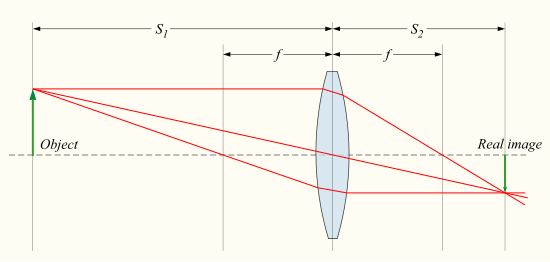Question
In: Physics
For what range of object positions does a bi-convex lens of focal length f form a...
For what range of object positions does a bi-convex lens of focal length f form a real image?
Solutions
Expert Solution

The Golden Gate Bridge refracted inrain droplets, which act as lenses
Image of a plant as seen through a biconvex lens.
If the distances from the object to the lens and from the lens to the image are S1 and S2 respectively, for a lens of negligible thickness, in air, the distances are related by the thin lens formula
 .
.
This can also be put into the "Newtonian" form:
 [21]
[21]
where  and
and  .
.
What this means is that, if an object is placed at a distance S1 along the axis in front of a positive lens of focal length f, a screen placed at a distance S2 behind the lens will have a sharp image of the object projected onto it, as long as S1 > f (if the lens-to-screen distance S2 is varied slightly, the image will become less sharp). This is the principle behind photography and the human eye. The image in this case is known as a real image.
Related Solutions
a convex lens has a focal length f. if an object is placed at a distance...
An object is located to the left of a convex lens whose focal length is f=34...
7. A convex lens has a focal length of f= 50cm. An object is placed 40cm...
A magnifying glass is a single convex lens with a focal length of f = +9.50...
1. Consider a convex lens with a focal length of 5.50 cm. An object is located...
An object 1cm tall is placed at 4cm from a convex lens with a focal length...
A. A convex lens has a focal length of 5.74704 cm. The object distance is 7.11538...
Q3- lens A to be a convex lens with a focal length of 20 cm, lens...
An object is placed in front of a lens with focal length f1, a second lens...
A symmetric double convex lens with a focal length of 28.0 cmcm is to be made...
- Complete the following TWO sets of questions. AREA 1: a. Identify an area of your self-concept...
- True or False - Du positive blood is regarded as Rh-negative for transfusion purposes.
- The variance of return on investment A is 144 percent squared while the variance of return...
- Use R studio to do it I need the code, thx. Write your own function, called...
- Design and implement a database for restaurant At the end you will submit a report that...
- The wavelengths of absorption of chromophores in electronic spectra are often influenced by the solvent. For...
- Objective: The purpose of this assignment is to: You understand and can work with C++ arrays,...
 genius_generous answered 8 months ago
genius_generous answered 8 months ago